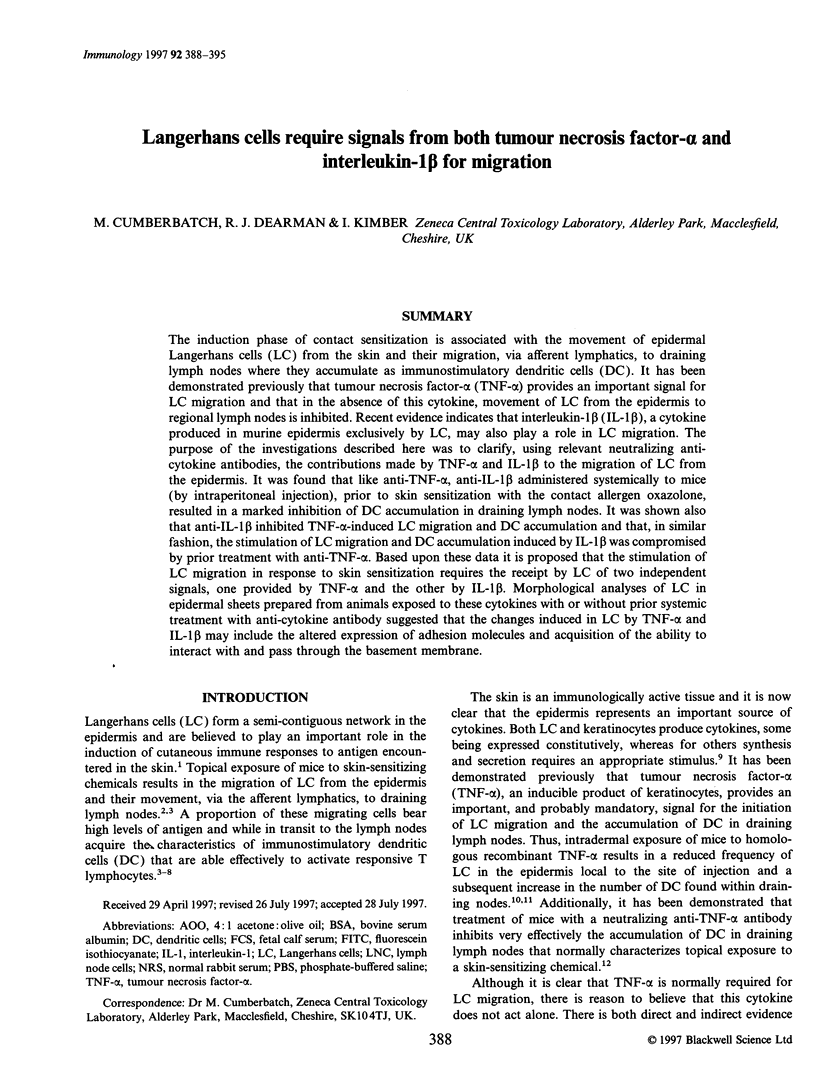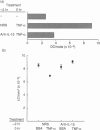Abstract
The induction phase of contact sensitization is associated with the movement of epidermal Langerhans cells (LC) from the skin and their migration, via afferent lymphatics, to draining lymph nodes where they accumulate as immunostimulatory dendritic cells (DC). It has been demonstrated previously that tumour necrosis factor-alpha (TNF-alpha) provides an important signal for LC migration and that in the absence of this cytokine, movement of LC from the epidermis to regional lymph nodes is inhibited. Recent evidence indicates that interleukin-1 beta (IL-1 beta), a cytokine produced in murine epidermis exclusively by LC, may also play a role in LC migration. The purpose of the investigations described here was to clarify, using relevant neutralizing anti-cytokine antibodies, the contributions made by TNF-alpha and IL-1 beta to the migration of LC from the epidermis. It was found that like anti-TNF-alpha, anti-IL-1 beta administered systemically to mice (by intraperitoneal injection), prior to skin sensitization with the contact allergen oxazolone, resulted in a marked inhibition of DC accumulation in draining lymph nodes. It was shown also that anti-IL-1 beta inhibited TNF-alpha-induced LC migration and DC accumulation and that; in similar fashion, the stimulation of LC migration and DC accumulation induced by IL-1 beta was compromised by prior treatment with anti-TNF-alpha. Based upon these data it is proposed that the stimulation of LC migration in response to skin sensitization requires the receipt by LC of two independent signals, one provided by TNF-alpha and the other by IL-1 beta. Morphological analyses of LC in epidermal sheets prepared from animals exposed to these cytokines with or without prior systemic treatment with anti-cytokine antibody suggested that the changes induced in LC by TNF-alpha and IL-1 beta may include the altered expression of adhesion molecules and acquisition of the ability to interact with and pass through the basement membrane.
Full text
PDF







Images in this article
Selected References
These references are in PubMed. This may not be the complete list of references from this article.
- Blauvelt A., Katz S. I., Udey M. C. Human Langerhans cells express E-cadherin. J Invest Dermatol. 1995 Feb;104(2):293–296. doi: 10.1111/1523-1747.ep12612830. [DOI] [PubMed] [Google Scholar]
- Borkowski T. A., Van Dyke B. J., Schwarzenberger K., McFarland V. W., Farr A. G., Udey M. C. Expression of E-cadherin by murine dendritic cells: E-cadherin as a dendritic cell differentiation antigen characteristic of epidermal Langerhans cells and related cells. Eur J Immunol. 1994 Nov;24(11):2767–2774. doi: 10.1002/eji.1830241129. [DOI] [PubMed] [Google Scholar]
- Cumberbatch M., Dearman R. J., Kimber I. Adhesion molecule expression by epidermal Langerhans cells and lymph node dendritic cells: a comparison. Arch Dermatol Res. 1996 Nov;288(12):739–744. doi: 10.1007/BF02505290. [DOI] [PubMed] [Google Scholar]
- Cumberbatch M., Dearman R. J., Kimber I. Interleukin 1 beta and the stimulation of Langerhans cell migration: comparisons with tumour necrosis factor alpha. Arch Dermatol Res. 1997 Apr;289(5):277–284. doi: 10.1007/s004030050193. [DOI] [PubMed] [Google Scholar]
- Cumberbatch M., Fielding I., Kimber I. Modulation of epidermal Langerhans' cell frequency by tumour necrosis factor-alpha. Immunology. 1994 Mar;81(3):395–401. [PMC free article] [PubMed] [Google Scholar]
- Cumberbatch M., Gould S. J., Peters S. W., Kimber I. MHC class II expression by Langerhans' cells and lymph node dendritic cells: possible evidence for maturation of Langerhans' cells following contact sensitization. Immunology. 1991 Nov;74(3):414–419. [PMC free article] [PubMed] [Google Scholar]
- Cumberbatch M., Kimber I. Dermal tumour necrosis factor-alpha induces dendritic cell migration to draining lymph nodes, and possibly provides one stimulus for Langerhans' cell migration. Immunology. 1992 Feb;75(2):257–263. [PMC free article] [PubMed] [Google Scholar]
- Cumberbatch M., Kimber I. Tumour necrosis factor-alpha is required for accumulation of dendritic cells in draining lymph nodes and for optimal contact sensitization. Immunology. 1995 Jan;84(1):31–35. [PMC free article] [PubMed] [Google Scholar]
- Cumberbatch M., Peters S. W., Gould S. J., Kimber I. Intercellular adhesion molecule-1 (ICAM-1) expression by lymph node dendritic cells: comparison with epidermal Langerhans cells. Immunol Lett. 1992 Apr;32(2):105–110. doi: 10.1016/0165-2478(92)90101-s. [DOI] [PubMed] [Google Scholar]
- Enk A. H., Angeloni V. L., Udey M. C., Katz S. I. An essential role for Langerhans cell-derived IL-1 beta in the initiation of primary immune responses in skin. J Immunol. 1993 May 1;150(9):3698–3704. [PubMed] [Google Scholar]
- Enk A. H., Katz S. I. Early molecular events in the induction phase of contact sensitivity. Proc Natl Acad Sci U S A. 1992 Feb 15;89(4):1398–1402. doi: 10.1073/pnas.89.4.1398. [DOI] [PMC free article] [PubMed] [Google Scholar]
- Heufler C., Topar G., Koch F., Trockenbacher B., Kämpgen E., Romani N., Schuler G. Cytokine gene expression in murine epidermal cell suspensions: interleukin 1 beta and macrophage inflammatory protein 1 alpha are selectively expressed in Langerhans cells but are differentially regulated in culture. J Exp Med. 1992 Oct 1;176(4):1221–1226. doi: 10.1084/jem.176.4.1221. [DOI] [PMC free article] [PubMed] [Google Scholar]
- Kimber I., Cumberbatch M. Dendritic cells and cutaneous immune responses to chemical allergens. Toxicol Appl Pharmacol. 1992 Dec;117(2):137–146. doi: 10.1016/0041-008x(92)90230-p. [DOI] [PubMed] [Google Scholar]
- Kimber I. Cytokines and regulation of allergic sensitization to chemicals. Toxicology. 1994 Sep 22;93(1):1–11. doi: 10.1016/0300-483x(94)90192-9. [DOI] [PubMed] [Google Scholar]
- Kinnaird A., Peters S. W., Foster J. R., Kimber I. Dendritic cell accumulation in draining lymph nodes during the induction phase of contact allergy in mice. Int Arch Allergy Appl Immunol. 1989;89(2-3):202–210. doi: 10.1159/000234947. [DOI] [PubMed] [Google Scholar]
- Knight S. C., Krejci J., Malkovsky M., Colizzi V., Gautam A., Asherson G. L. The role of dendritic cells in the initiation of immune responses to contact sensitizers. I. In vivo exposure to antigen. Cell Immunol. 1985 Sep;94(2):427–434. doi: 10.1016/0008-8749(85)90266-7. [DOI] [PubMed] [Google Scholar]
- Kobayashi Y. Langerhans' cells produce type IV collagenase (MMP-9) following epicutaneous stimulation with haptens. Immunology. 1997 Apr;90(4):496–501. doi: 10.1046/j.1365-2567.1997.00212.x. [DOI] [PMC free article] [PubMed] [Google Scholar]
- Kripke M. L., Munn C. G., Jeevan A., Tang J. M., Bucana C. Evidence that cutaneous antigen-presenting cells migrate to regional lymph nodes during contact sensitization. J Immunol. 1990 Nov 1;145(9):2833–2838. [PubMed] [Google Scholar]
- Kämpgen E., Koch F., Heufler C., Eggert A., Gill L. L., Gillis S., Dower S. K., Romani N., Schuler G. Understanding the dendritic cell lineage through a study of cytokine receptors. J Exp Med. 1994 Jun 1;179(6):1767–1776. doi: 10.1084/jem.179.6.1767. [DOI] [PMC free article] [PubMed] [Google Scholar]
- Larregina A., Morelli A., Kolkowski E., Fainboim L. Flow cytometric analysis of cytokine receptors on human Langerhans' cells. Changes observed after short-term culture. Immunology. 1996 Feb;87(2):317–325. doi: 10.1046/j.1365-2567.1996.451513.x. [DOI] [PMC free article] [PubMed] [Google Scholar]
- Lewis M., Tartaglia L. A., Lee A., Bennett G. L., Rice G. C., Wong G. H., Chen E. Y., Goeddel D. V. Cloning and expression of cDNAs for two distinct murine tumor necrosis factor receptors demonstrate one receptor is species specific. Proc Natl Acad Sci U S A. 1991 Apr 1;88(7):2830–2834. doi: 10.1073/pnas.88.7.2830. [DOI] [PMC free article] [PubMed] [Google Scholar]
- Ma J., Wang J. H., Guo Y. J., Sy M. S., Bigby M. In vivo treatment with anti-ICAM-1 and anti-LFA-1 antibodies inhibits contact sensitization-induced migration of epidermal Langerhans cells to regional lymph nodes. Cell Immunol. 1994 Oct 15;158(2):389–399. doi: 10.1006/cimm.1994.1285. [DOI] [PubMed] [Google Scholar]
- Macatonia S. E., Edwards A. J., Knight S. C. Dendritic cells and the initiation of contact sensitivity to fluorescein isothiocyanate. Immunology. 1986 Dec;59(4):509–514. [PMC free article] [PubMed] [Google Scholar]
- Macatonia S. E., Knight S. C., Edwards A. J., Griffiths S., Fryer P. Localization of antigen on lymph node dendritic cells after exposure to the contact sensitizer fluorescein isothiocyanate. Functional and morphological studies. J Exp Med. 1987 Dec 1;166(6):1654–1667. doi: 10.1084/jem.166.6.1654. [DOI] [PMC free article] [PubMed] [Google Scholar]
- Matsue H., Cruz P. D., Jr, Bergstresser P. R., Takashima A. Langerhans cells are the major source of mRNA for IL-1 beta and MIP-1 alpha among unstimulated mouse epidermal cells. J Invest Dermatol. 1992 Nov;99(5):537–541. doi: 10.1111/1523-1747.ep12667296. [DOI] [PubMed] [Google Scholar]
- Rambukkana A., Pistoor F. H., Bos J. D., Kapsenberg M. L., Das P. K. Effects of contact allergens on human Langerhans cells in skin organ culture: migration, modulation of cell surface molecules, and early expression of interleukin-1 beta protein. Lab Invest. 1996 Feb;74(2):422–436. [PubMed] [Google Scholar]
- Ryffel B., Brockhaus M., Greiner B., Mihatsch M. J., Gudat F. Tumour necrosis factor receptor distribution in human lymphoid tissue. Immunology. 1991 Nov;74(3):446–452. [PMC free article] [PubMed] [Google Scholar]
- Sarén P., Welgus H. G., Kovanen P. T. TNF-alpha and IL-1beta selectively induce expression of 92-kDa gelatinase by human macrophages. J Immunol. 1996 Nov 1;157(9):4159–4165. [PubMed] [Google Scholar]
- Scheynius A., Camp R. L., Puré E. Unresponsiveness to 2,4-dinitro-1-fluoro-benzene after treatment with monoclonal antibodies to leukocyte function-associated molecule-1 and intercellular adhesion molecule-1 during sensitization. J Immunol. 1996 Mar 1;156(5):1804–1809. [PubMed] [Google Scholar]
- Schwarzenberger K., Udey M. C. Contact allergens and epidermal proinflammatory cytokines modulate Langerhans cell E-cadherin expression in situ. J Invest Dermatol. 1996 Mar;106(3):553–558. doi: 10.1111/1523-1747.ep12344019. [DOI] [PubMed] [Google Scholar]
- Shornick L. P., De Togni P., Mariathasan S., Goellner J., Strauss-Schoenberger J., Karr R. W., Ferguson T. A., Chaplin D. D. Mice deficient in IL-1beta manifest impaired contact hypersensitivity to trinitrochlorobenzone. J Exp Med. 1996 Apr 1;183(4):1427–1436. doi: 10.1084/jem.183.4.1427. [DOI] [PMC free article] [PubMed] [Google Scholar]
- Tang A., Amagai M., Granger L. G., Stanley J. R., Udey M. C. Adhesion of epidermal Langerhans cells to keratinocytes mediated by E-cadherin. Nature. 1993 Jan 7;361(6407):82–85. doi: 10.1038/361082a0. [DOI] [PubMed] [Google Scholar]
- Trefzer U., Brockhaus M., Loetscher H., Parlow F., Kapp A., Schöpf E., Krutmann J. 55-kd tumor necrosis factor receptor is expressed by human keratinocytes and plays a pivotal role in regulation of human keratinocyte ICAM-1 expression. J Invest Dermatol. 1991 Nov;97(5):911–916. doi: 10.1111/1523-1747.ep12491668. [DOI] [PubMed] [Google Scholar]
- Wang B., Kondo S., Shivji G. M., Fujisawa H., Mak T. W., Sauder D. N. Tumour necrosis factor receptor II (p75) signalling is required for the migration of Langerhans' cells. Immunology. 1996 Jun;88(2):284–288. doi: 10.1111/j.1365-2567.1996.tb00016.x. [DOI] [PMC free article] [PubMed] [Google Scholar]








